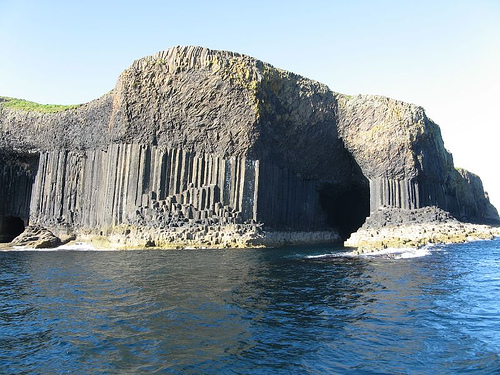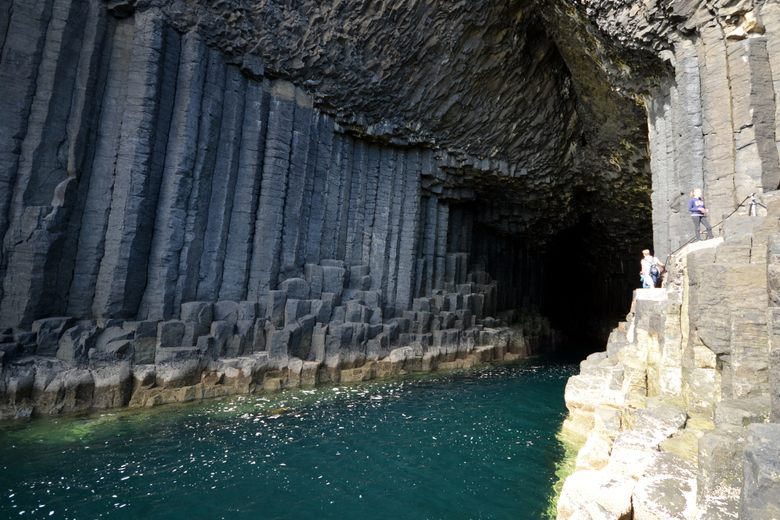Fingal's Cave is a sea cave located on the uninhabited island of Staffa, which is part of the Inner Hebrides archipelago in Scotland. The cave was formed by lava flows and is known for its unique hexagonal basalt columns.
The cave is approximately 75 meters long and up to 20 meters high, with a width of around 14 meters. The columns are made up of mostly hexagonal shapes, which fit together like giant puzzle pieces to create the cave's distinctive appearance.
The cave is named after the Irish mythological character Fingal, who is said to have built a bridge from Scotland to Ireland. The cave's Gaelic name is "Uamh-Binn" which means "cave of melody" due to the echoing sounds made by the waves crashing against the columns.
Fingal's Cave has been a popular destination for tourists since the 18th century and has inspired many artists and musicians, including the composer Felix Mendelssohn, who wrote an overture based on the cave's acoustics.
Visitors can reach Fingal's Cave by boat from the nearby islands of Mull and Iona. However, the cave can be difficult to access due to rough seas, and visitors are advised to check weather conditions before attempting to visit.
Fingal's Cave is popular and famous for several reasons:
-
Its unique natural beauty: The cave's hexagonal basalt columns, created by volcanic activity millions of years ago, give it a distinctive appearance that is unlike any other cave in the world.
-
Its acoustics: The echoing sounds made by the waves crashing against the columns create a natural symphony that has inspired musicians and artists for centuries.
-
Its mythological and historical significance: The cave is named after the mythological Irish character Fingal and has been associated with legends and stories for centuries. It has also been visited by notable figures throughout history, including Sir Joseph Banks, who visited the cave in 1772.
-
Its location: Fingal's Cave is located on the remote island of Staffa, which adds to its mystique and allure. The rugged beauty of the surrounding landscape and the fact that the cave can only be accessed by boat make it a popular destination for adventure-seekers and nature-lovers.
Overall, Fingal's Cave is a unique and stunning natural wonder that has captured the imagination of people for centuries. Its beauty, acoustics, history, and location have all contributed to its enduring popularity and fame.
Fingal's Cave is primarily a tourist destination and not a living place. The cave is located on the uninhabited island of Staffa, which has no permanent residents. The island is a protected area and managed by the National Trust for Scotland.
Visitors to the cave can experience its natural beauty, acoustics, and historical significance. The cave is accessible only by boat and can be reached from nearby islands such as Mull and Iona. However, due to the rough seas and unpredictable weather in the area, visiting the cave can be challenging and weather-dependent.
Although Fingal's Cave is not a living place, it is an important natural and cultural site. The cave's unique geological formations and the sounds created by the crashing waves have inspired artists, musicians, and writers for centuries. It has been celebrated in poetry, art, and music, including Felix Mendelssohn's famous overture, "The Hebrides," which was inspired by his visit to Fingal's Cave in 1829.
Visitors to Fingal's Cave can enjoy a range of activities, including:
-
Exploring the cave: Visitors can walk into the cave and experience the unique hexagonal basalt columns up close. The cave is approximately 75 meters long and up to 20 meters high, and the columns create a stunning visual display.
-
Listening to the acoustics: The echoing sounds made by the waves crashing against the columns create a natural symphony that visitors can experience by standing inside the cave.
-
Taking photos: Fingal's Cave is a beautiful natural wonder, and visitors can capture stunning photos of the cave's columns, the surrounding sea, and the rugged landscape of the island.
-
Wildlife watching: The island of Staffa is home to a variety of seabirds, including puffins, guillemots, and razorbills. Visitors can watch these birds in their natural habitat and enjoy the island's rugged beauty.
-
Boat tours: Visitors can take boat tours to Fingal's Cave from nearby islands such as Mull and Iona. These tours provide a unique perspective on the cave and allow visitors to appreciate its size and beauty from the water.
-
Hiking: Visitors can explore the island of Staffa and enjoy its rugged beauty by taking a hike along the island's coastal paths. The island offers stunning views of the sea and the surrounding landscape.
Overall, visitors to Fingal's Cave can enjoy a range of activities that allow them to appreciate the cave's natural beauty, acoustics, and historical significance.
Here are ten random facts about Fingal's Cave:
-
Fingal's Cave is located on the island of Staffa, which is part of the Inner Hebrides archipelago in Scotland.
-
The cave was formed by lava flows and is made up of hexagonal basalt columns that fit together like giant puzzle pieces.
-
The cave is named after the mythological Irish character Fingal, who is said to have built a bridge from Scotland to Ireland.
-
The cave's Gaelic name is "Uamh-Binn," which means "cave of melody" due to the echoing sounds made by the waves crashing against the columns.
-
The cave is approximately 75 meters long and up to 20 meters high, with a width of around 14 meters.
-
Visitors to the cave can experience its unique acoustics, which have inspired musicians and artists for centuries.
-
The cave has been a popular destination for tourists since the 18th century, and notable figures throughout history, including Sir Joseph Banks, have visited the cave.
-
Fingal's Cave was the inspiration for Felix Mendelssohn's overture, "The Hebrides," which he composed after visiting the cave in 1829.
-
The island of Staffa, where the cave is located, is home to a variety of seabirds, including puffins, guillemots, and razorbills.
-
The cave is accessible only by boat and can be reached from nearby islands such as Mull and Iona, but visiting is weather-dependent due to the rough seas in the area.
Isle of Staffa
N4 1EE
United Kingdom


